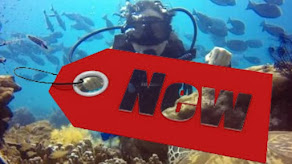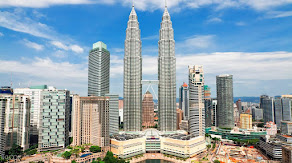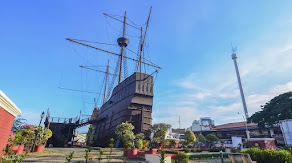Sipadan Island, Semporna, Sabah, Malaysia (Borneo)
The internationally famous island of Sipadan lies five degrees north of the
equator in the Sulawesi Sea (Celebes Sea). Lying 35km south of Semporn, on Sabah’s
mainland, like many tropical islands it is thickly forested and surrounded by
sandy beaches. Sipadan is an oceanic island and was formed by living corals
growing on top of an extinct undersea volcano, which rises 600m from the
seabed.
Sipadan Island was established as a bird sanctuary in 1933 and in 2004, the
Government of Malaysia has decided that all onsite dive resort operators are to
move their operations out of Sipadan Island by 31st December 2004. The island
is open for divers from 6am to 4pm - no night dives are allowed. The number of
divers allowed to dive in Sipadan daily has also been limited to 120 pax in an
effort to preserve the island’s pristine state.
Sipadan is a treasure which we want to save for the generations to come, before
Sipadan can be saved, it must first be truly appreciated - hence the
conservation efforts. Nevertheless, a treasure amounts to nothing if it cannot
be enjoyed. Therefore, Sabah welcomes everyone to enjoy and appreciate Sipadan,
and this appreciation will hopefully incite a bigger desire to save.
The Barracuda Point is located at the north Coast of Sipadan Island. Famous for
its astounding vortex of barracudas (hence the name Barracuda Point), divers
have also reported sightings of white tip sharks, grey reef sharks, eagle rays,
turtles, as well as the bumphead parrotfish. A caveat: currents can get too
strong, so don't go too deep!
Turtle Cavern
This site is famous for its population of green turtles and smaller hawksbill turtles. This cavern which lies 20 meters underwater is believed to be the final resting place of turtles. Divers are reminded to be extremely careful when exploring the caves as visibility can be drastically reduced to zero should the silt be disturbed.
South Point
South Point is one of the most likely sites for the rarer sharks such as the hammerheads and thresher sharks which are normally only seen around the 40-meter point. Divers are advised to be wary of the strong currents at this site.
Hanging Gardens
Named after the Hanging Gardens of Babylon, the topography of the Hanging Gardens consists of a 2-meter-deep reef that slopes down to a terrace at about 70 meters which subsequently plunges into an abyss. This is an excellent spot to view soft corals with dendronephthya alcyonarians in multifarious pastel colours encrusting the slope. Do keep an eye also for the diverse macro life.
“I have seen other places like
Sipadan 45 years ago. Now we have found again an untouched piece of art”.
- Jacques-Yves Cousteau
The geographic position of Sipadan puts it in the centre of the richest
marine habitat in the world, the heart of the Indo-Pacific basin. More than 3000
species of fish and hundreds of coral species have been classified in
this richest of ecosystems. Sipadan is well known for its unusually large
numbers of green and hawksbill turtles which gather there to
mate and nest and it is not unusual for a diver to see more than 20
turtles on each dive. Another unique feature to divers visiting Sipadan
is the turtle tomb, an underwater limestone cave with a
labyrinth of tunnels and chambers that contain many skeletal remains of turtles
that became disoriented and then drowned.
The residential schooling barracuda and big-eye trevally,
which often gather in thousands forming spectacular tornado-like formations,
are one of the highlights of every diver’s wish-list. With the possibility of
seeing pelagic species such as mantas, eagle rays, scalloped hammerhead sharks
and whale sharks, each dive at Sipadan is a highly anticipated event.
It is not only the big fish that amaze divers coming to Sipadan, the macro
life is equally mesmerizing. Garden eels, leaf scorpion fish, mantis shrimps,
fire gobies, and various pipefish are guaranteed at various dive sites. The
diversity and abundance of marine found at Sipadan gives it its reputation of
being one of the ten best dive locations in the world.
Conservation efforts in Sipadan
Sipadan Dive Sites
There a total of 12 dive sites in Sipadan Island namely the West Ridge, North
Point, The Drop Off, Turtle Cavern, Barracuda Point, Coral Gardens, Whitetip
Avenue, Mid Reef, Turtle Patch, South Point, Staghorn Crest, Lobster Lair, and
the Hanging Gardens. The most popularly recommended dive sites are the Turtle
Cavern, Barracuda Point, South Point and Hanging Gardens.
Barracuda Point
Barracuda Point
Turtle Cavern
This site is famous for its population of green turtles and smaller hawksbill turtles. This cavern which lies 20 meters underwater is believed to be the final resting place of turtles. Divers are reminded to be extremely careful when exploring the caves as visibility can be drastically reduced to zero should the silt be disturbed.
South Point
South Point is one of the most likely sites for the rarer sharks such as the hammerheads and thresher sharks which are normally only seen around the 40-meter point. Divers are advised to be wary of the strong currents at this site.
Hanging Gardens
Named after the Hanging Gardens of Babylon, the topography of the Hanging Gardens consists of a 2-meter-deep reef that slopes down to a terrace at about 70 meters which subsequently plunges into an abyss. This is an excellent spot to view soft corals with dendronephthya alcyonarians in multifarious pastel colours encrusting the slope. Do keep an eye also for the diverse macro life.
Where to Stay
The Malaysian government has decided
that all existing onsite dive resort operators were to move their operations out
of the Sipadan Island by 31st December 2004. The move is aimed at conserving
and maintaining a balanced marine and land ecosystem on Sipadan’s environments.
However, Sipadan will remain as a dive site and divers are to be ferried by
operators operating from the mainland or nearby islands other than Sipadan and
Ligitan.
On an overnight trip to Sipadan ,
choose to stay in any one of these excellent resorts:
- Borneo Divers & Sea Sports (Sabah) Sdn Bhd (KPL 1510)
- Explore Asia Tours Sdn Bhd (Sipadan-Mabul Resort) (KPL 2941)
- Seaventures Tours & Travel Sdn Bhd (KPL/LN 2639)
- Sipadan Water Village Resort
Sdn Bhd (KPL 3143)
* Resort rates may vary
Getting There
From kota kinabalu, take a 55-minute
flight to Tawau and enjoy an hour’s drive to Semporna. From Semporna, Sipadan is
another 40 minutes by speedboat. Be sure to pre-arrange transportation with
your respective resort/dive operator.
More Information
For booking and enquiries, please
refer to the list of Sabah Dive Operators










































